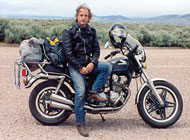How Effective Are Helmets Really?
Some motorcyclists who die in crashes do so while wearing helmets, while others do so without helmets. This led Bruce Downs to the question, how many of those fatally injured actually die of head wounds?
The heart of this question was exemplified by a photo that was making the rounds several years ago, of a motorcyclist in such an horrific crash that he was cut in two. Someone made the remark, “Good thing he was wearing a helmet.”
So Bruce was asking the question and he was in a good position to come up with an answer. Bruce is State Coordinator for ABATE of Colorado and he raised this question at a MOSAB meeting. MOSAB is the Motorcycle Operator Safety Advisory Board, which is made up of representatives from rider organizations, the Colorado State Patrol, and others. When Bruce asked this question, he tells us, the representative from the state patrol said that he, too, would like an answer to that question. “And you’re going to get it for us, aren’t you,” he said to Bruce.
Now, you or I might not be able to corral the assistance such an endeavor might need but with the weight of MOSAB and the state patrol on his side Bruce was able to do so. I’m not sure who he worked with on this but three simple questions were decided upon, which were put up on Survey Monkey, and they then contacted 11 county coroner offices around Colorado, asking that every time the office deals with a motorcycle fatality that someone answer the three survey questions.
One question was, was this a single vehicle crash or were there more vehicles involved? Second, was the deceased wearing a helmet? Third was, was a head injury the cause of death?
In one county the coroner declined to participate, saying that in every motorcycle fatality he sees the death is due to multiple blunt force trauma. That is to say, it’s impossible to say conclusively what the rider died of because there were so many different, severe injuries that you just can’t isolate one in particular. If he/she didn’t die of this then he/she still would have died of that.
Among those coroners who did agree to participate, however, results have been coming in. And guess what? In approximately 80 percent of the fatalities reported–evenly divided between helmeted and helmetless–the cause of death was given as multiple blunt force trauma. (Bruce didn’t specify what the other 20 percent were; I ought to ask him that.)
Where this leads him, Bruce told us, and what he was planning to tell MOSAB the following day, was that regardless of what some people might wish to be the case, helmets are not that big a factor in saving lives. What would be a big factor in saving lives would be to reduce the number of crashes. And what will make that happen is educating drivers and riders, getting drivers off their cellphones while they’re driving, and so many other factors that will add up. But to anyone who thinks a helmet law would be all the answer needed, he says get over it.
“If you want to continue with the rhetoric you’re not going to get where you want to go. It’s not a short fix, it’s a long fix but you’ve got to get started.”
The reason this all matters is that the Colorado State Patrol has been given explicit direction to reduce highway fatalities. The people running that effort want real answers and it’s this kind of data collection that will help provide those answers.
Biker Quote for Today
You know you’re a biker if you get hit by a car, break your leg, then tell the nice police officer, “I’m fine I can ride home.”
Tags: helmets and fatalities

